Cookbook #237: Encyclopedia of Cookery, Vol. 12, Top-Z-Index, Woman’s Day, Fawcett Publications, NY, 1967.
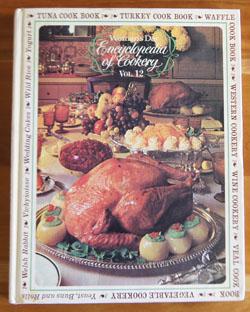 I am on the final 15 cookbooks in my “250 Cookbooks” database! It’s time to do the last Encyclopedia of Cookery in my collection. I open the volume and settle in to another discovery of unusual food items and historical trivia. As well as some useful recipes, of course. Encyclopedia of Cookery, Vol. 12, Top-Z-Index covers “topping” to “zwieback”.
I am on the final 15 cookbooks in my “250 Cookbooks” database! It’s time to do the last Encyclopedia of Cookery in my collection. I open the volume and settle in to another discovery of unusual food items and historical trivia. As well as some useful recipes, of course. Encyclopedia of Cookery, Vol. 12, Top-Z-Index covers “topping” to “zwieback”.
A very, very useful feature is in this volume: the complete recipe index for volumes 1 to 12. This 96-page index takes up almost half the book. It is invaluable to search the entire set for foods and recipes. I feel lucky to have the entire, intact set.
What is a torte? It is a rich cake, made with eggs, sugar, jam, liqueur, (very little) flour, and nuts or dry bread crumbs. Often a luscious filling is spread between cake-like layers. Next are recipes for tortillas (I’ve run across a lot of tortilla recipes in my journey through this blog). Tortoni is an Italian dessert made from liquor- or sherry-flavored whipped cream combined with macaroon crumbs. The mixture is put into little paper cups, sprinkled with crumbs and almonds, and frozen. Yum. Trifle is another dessert; of English origin, it is made from jam-covered, spirit-soaked sponge cake, with a rich custard and whipped cream and fancy almonds and glacé fruit on top. It’s also known as a “tipsy cake”. I’d love these three desserts, as I wake to a Valentine’s Day morning with no hopes of anything but protein and vegetables for the day.
Tripe? I actually bought it once years ago. It’s the inner lining of the stomach of beef. I don’t like it. But I do like trout, especially the rainbow trout we get in Colorado, and especially if very fresh and wild-caught. (I am not a fisherwoman. Although there are photos of me when young with a fishing pole, happily catching fish in the High Sierras.)
Enjoy with me this entry from Lucy Kavaler on legends of the elusive truffle:
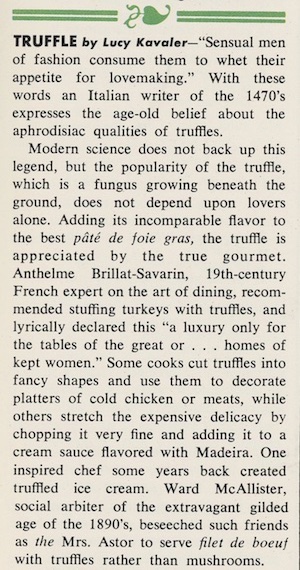 And now from truffles to the lowly can of tuna. I am not surprised to find a “Tuna Cook Book” in this 1960s cookbook. “Tonno con Piselli” is tuna with peas, yes, just canned tuna and peas. The “Tuna-Macaroni Bake” is like the tuna casseroles I remember; this one is topped with crushed potato chips. (I love potato chips on tuna sandwiches.)
And now from truffles to the lowly can of tuna. I am not surprised to find a “Tuna Cook Book” in this 1960s cookbook. “Tonno con Piselli” is tuna with peas, yes, just canned tuna and peas. The “Tuna-Macaroni Bake” is like the tuna casseroles I remember; this one is topped with crushed potato chips. (I love potato chips on tuna sandwiches.)
Turkeys are native to America. I guess I knew this fact, but it’s not the first thing I think of when I think “turkey”. They were domesticated by native Americans. Here is Ben Franklin talking about bald eagles and turkeys:
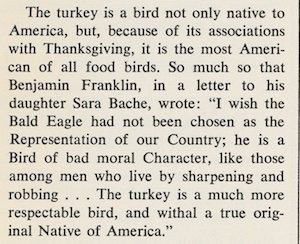 The Turkey Cook Book might be useful because it has a lot of recipes for using leftover turkey. Next come turmeric, turnip, and turnovers. Oh, turtle soup! And if I want to know how to dress a live turtle:
The Turkey Cook Book might be useful because it has a lot of recipes for using leftover turkey. Next come turmeric, turnip, and turnovers. Oh, turtle soup! And if I want to know how to dress a live turtle:
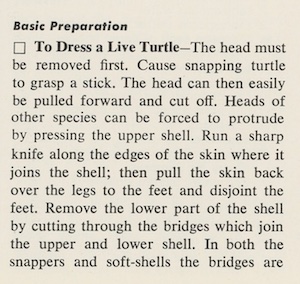
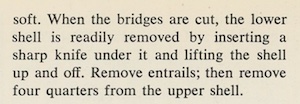
Upside-down cakes include a recipe for blueberry upside-down cake, which I’d surely like to try. “Utensil” gives a check list of utensils needed in a well-equipped kitchen. Let’s see, I have beaters and mixers, a blender, cutting boards, bowls, deep fryer, egg poachedr, ice-cream freezer, pressure cooker, rolling pin, teapot, thermometers, toaster . . . looks like I am good to go. Vacherin is a “delicious creamy white dessert cheese” from Switzerland or France. Vanilla is from a plant related to orchids. (And boy, has vanilla gotten expensive lately! I just bought a small bottle yesterday for nineteen dollars!) I am not a fan of veal, but this Encyclopedia has a Veal Cook Book.
James Beard wrote the section on Vegetable Cookery. He and I are like-minded: don’t overcook vegetables. I’d like to try his recipe for Braised Leeks and one for Zucchini with Walnuts. Gratin of Greens is suitable for a no-carb diet, and Tangerine Swirls is an interesting take on sweet potatoes. I learn that Vichyssoise is a “very elegant cold leek and potato soup”. It has lots of cream in it and is served cold.
A “vinaigrette” need only be a mixture of oil and vinegar, salt and pepper, but can have herbs. While traveling in Paris and London, sometimes there was a bottle of oil and a bottle of vinegar at the table, meant for salads. If it’s not mixed, I guess it’s not a vinaigrette. (My vinaigrette recipe is here.) Vinegar itself has a long history, stretching back thousands of years. Yeast fell into fruit juice and it turned into wine, and bacteria fell into wine and turned it to vinegar. “Vin aigre” is French for “sour wine”. (As a chemist, I know vinegar as containing acetic acid and water.) Here’s a section from this book on vinegar:
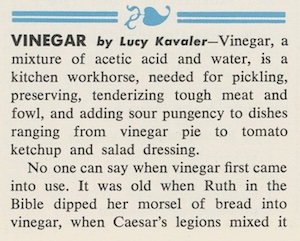
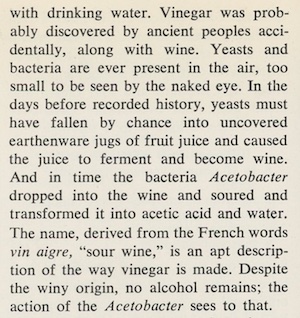
Vitamin, vodka, vol-au-lent (a puff pastry formed into an enormous patty shell). I’d like to try the Old-Colony Gingerbread Waffles. “Water” has it’s own entry. Water chestnuts are a “fruit of a water plant”, common in Asia, shaped like a tree-chestnut, and crispy in texture. Watercress, watermelon, and welsh rabbit or rarebit (melted cheese on toast, often with beer or wine added to the rabbit).
“Western Cookery” begins with a long essay by Idwal Jones. She describes “western” as the cooking of California, Oregon, and Washington.
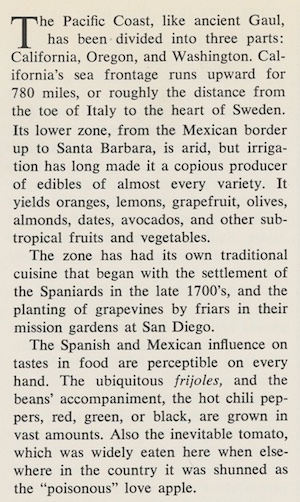 “There is a mystifying phenomenon in the order of courses in the West.” Namely, salads are served first. Yay for California for starting this trend! It’s the rule at my house, and I learned it from my college roommates.
“There is a mystifying phenomenon in the order of courses in the West.” Namely, salads are served first. Yay for California for starting this trend! It’s the rule at my house, and I learned it from my college roommates.
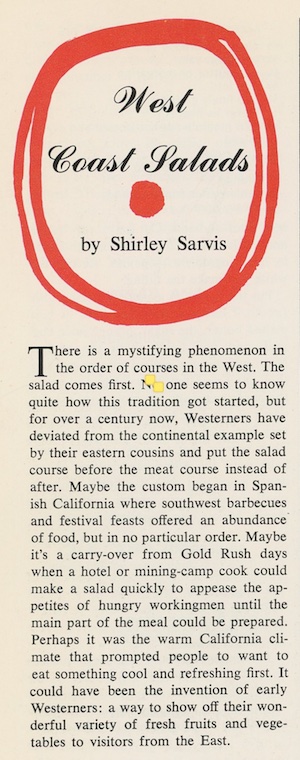 In the 1960s, one could find frozen whale steaks in local specialty food stores, and I learn that 3 1/2 ounces raw whale has 156 calories. Apparently you could still find whale meat at online specialty shops in the 1960s (and maybe online today). Lots of fish begins with “wh” – white fish, whiting, and whitebait are examples. And of course two of my favorite things begin “wh” – wheat and whiskey. Wild rice is a native American grass that is not directly related to Asian rice.
In the 1960s, one could find frozen whale steaks in local specialty food stores, and I learn that 3 1/2 ounces raw whale has 156 calories. Apparently you could still find whale meat at online specialty shops in the 1960s (and maybe online today). Lots of fish begins with “wh” – white fish, whiting, and whitebait are examples. And of course two of my favorite things begin “wh” – wheat and whiskey. Wild rice is a native American grass that is not directly related to Asian rice.
The wine entry takes up many pages. I skip them. Maybe I’ll come back to them another time.
Worcestershire sauce contains garlic, soy, vinegar, anchovies, tamarinds, onions, shallots, molasses, sugar, salt, and spices. It originated in England. Wormwood flavors the “powerful spirit” absinthe. This book states that absinthe is illegal in the US (and I think it still is, although other countries allow its sale).
Yams are tubers grown mainly in the tropics. But what about those “yams” that I see in local stores? There are a few varieties of moist-fleshed yams grown our country. Mostly, though, we see sweet potatoes. “People often think that yams and sweet potatoes are the same thing, but although they resemble each other closely in taste, they belong to entirely different families of plants.” (I discuss yams at the end of another post.)
Lucy Kavaler wrote a long article on “yeast”, and Helen Evans Brown wrote “How to Cook Superbly: Yeast Rolls and Buns”. Yogurt is a “semisolid milk product that has been made acid by the addition of bacterial cultures”. Yorkshire pudding is a savory British dish made by baking a batter of egg, milk, and flour in beef drippings.
Zabaglione is an Italian dessert of eggs, sugar, and wine, and zeppole is an Italian doughnutlike pastry. (Yes, I guess doughnutlike is a word, according to Wiktionary.) Zucchini also comes from Italy.
And the last entry, on page 1962 of the entire Encyclopedia of Cooking volumes, is zwieback. These are “a sweet biscuit or rusk which is first baked and then sliced and toasted in the oven to make it into a kind of dry toast. The word comes from the German, and means “baked twice”.
I decide to make one of the “West Coast Salads” for this blog: California Parmesan-Walnut Salad.
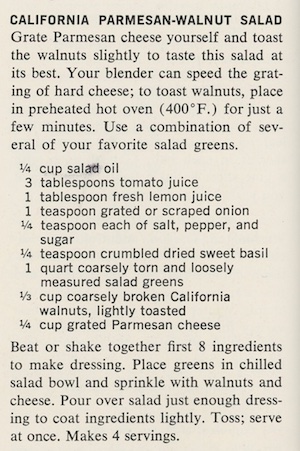 I like this salad for several reasons. I love toasted walnuts in salads. I like Parmesan cheese too, especially when it is freshly grated from a chunk of Parmigiano Reggiano. I like the fact that you make a special salad dressing, just enough for this salad. And, I like using “coarsely torn and loosely measured salad greens”. That’s my typical way of making salads! I am sure I used a lot more salad greens than one cup per person, though. I like my salads.
I like this salad for several reasons. I love toasted walnuts in salads. I like Parmesan cheese too, especially when it is freshly grated from a chunk of Parmigiano Reggiano. I like the fact that you make a special salad dressing, just enough for this salad. And, I like using “coarsely torn and loosely measured salad greens”. That’s my typical way of making salads! I am sure I used a lot more salad greens than one cup per person, though. I like my salads.
If you don’t keep small amounts of tomato juice in your pantry or refrigerator, you can use diluted tomato sauce. (I buy single serving cans of tomato juice because I often add just a bit to a sauce.) Or use V-8 juice. Or, use and entirely different salad dressing.
California Parmesan-Walnut Salad
serves 2-4
- 1/4 cup salad oil (I used extra virgin olive oil)
- 3 tablespoons tomato juice
- 1 tablespoon fresh lemon juice
- 1 teaspoon grated onion (you could use dried onion from a jar)
- 1/4 teaspoon each: salt, pepper, sugar, and dried basil
- about 4 cups mixed salad greens (if you use large leaf lettuce, tear it into pieces)
- 1/3 cup walnuts (toasted); whole-halves or coarsely broken
- 1/4 cup freshly grated Parmesan cheese
To toast the walnuts, heat a pan on the stove top, then add the walnuts and stir and watch constantly until they begin to brown – watch them closely because they can burn quite quickly. Or, put them in a 450˚ oven for – again – just a few minutes, watching closely.
Mix the oil, tomato juice, lemon juice, onion, and seasonings in a bowl with a whisk or in a lidded jar.
Plate the greens, sprinkle with walnuts and cheese. Pour just enough of the salad dressing to coat the ingredients lightly. (Or, place the salad ingredients in a bowl, add dressing, and toss lightly.) Serve at once.
 This is a great-tasting salad that I will make again. Refreshing, after my usual salads overladen with fresh cut vegetables. Entirely suitable for a special dinner! Note that I used walnut halves. Coarsely broken walnuts might give a slightly different taste to this salad.
This is a great-tasting salad that I will make again. Refreshing, after my usual salads overladen with fresh cut vegetables. Entirely suitable for a special dinner! Note that I used walnut halves. Coarsely broken walnuts might give a slightly different taste to this salad.
I goofed and added 1 tablespoon of grated onion instead of 1 teaspoon. Next time, I’ll either finely chop just a teaspoon of fresh onion or shallot, or I’ll use a quarter teaspoon of dried onion powder or flakes.
And so I come to the end of my coverage of the set of Woman’s Day Encyclopedia of Cooking, begun with “abalone” on November 19, 2012 in the Encyclopedia of Cooking, Volume 1. Abalone to zwieback. A good journey.
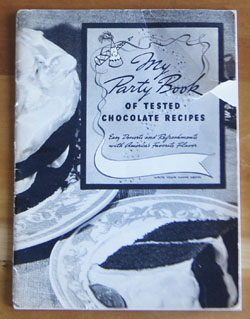 1938. It’s amazing this vintage cookbook has lasted this long! One tear in the front cover is the only flaw. I open to the first page:
1938. It’s amazing this vintage cookbook has lasted this long! One tear in the front cover is the only flaw. I open to the first page: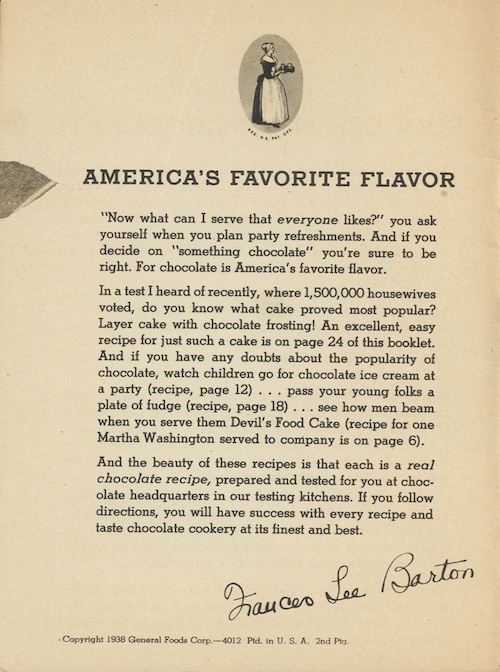 “How to have success with chocolate” is the second page:
“How to have success with chocolate” is the second page: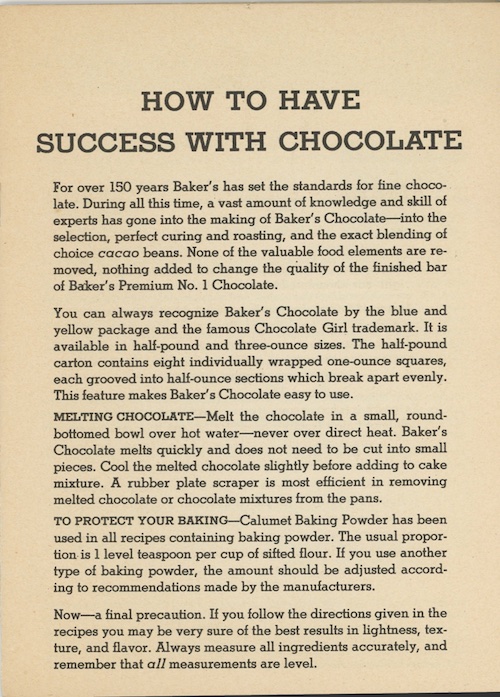 “For over150 years Baker’s has set the standards for fine chocolate”. Since this book was published in 1938, that means Baker’s Chocolate was formed in 1788 or earlier. Let’s check. I pull up Wikipedia’s entry for Baker’s Chocolate. In 1764, John Hannon and Dr. James Baker of Massachusetts began a business importing cocoa beans from the West Indies. Dr. Baker took over the company in 1780, when Hannon did not return from a sailing trip. Baker renamed the company “Baker’s Chocolate”. So, the claim is correct. Chocolate itself was discovered in meso-America (Wikipedia’s History of Chocolate). The Americas had chocolate before Europe – sometimes I forget that!
“For over150 years Baker’s has set the standards for fine chocolate”. Since this book was published in 1938, that means Baker’s Chocolate was formed in 1788 or earlier. Let’s check. I pull up Wikipedia’s entry for Baker’s Chocolate. In 1764, John Hannon and Dr. James Baker of Massachusetts began a business importing cocoa beans from the West Indies. Dr. Baker took over the company in 1780, when Hannon did not return from a sailing trip. Baker renamed the company “Baker’s Chocolate”. So, the claim is correct. Chocolate itself was discovered in meso-America (Wikipedia’s History of Chocolate). The Americas had chocolate before Europe – sometimes I forget that!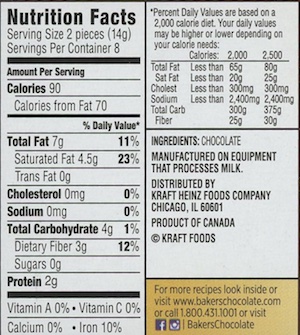 From the above label, we can see that one-half an ounce of baking chocolate has 90 calories, 78% from from fat, with a small amount of dietary fiber and 2 grams of protein. No vitamin A or C, no calcium, but some iron. Valuable food elements, yes, I guess. But nowadays – unlike 1938 – chocolate, especially dark chocolate, has been found to be chock-full of trace nutrients and antioxidants and more, as in this article on HealthLine.
From the above label, we can see that one-half an ounce of baking chocolate has 90 calories, 78% from from fat, with a small amount of dietary fiber and 2 grams of protein. No vitamin A or C, no calcium, but some iron. Valuable food elements, yes, I guess. But nowadays – unlike 1938 – chocolate, especially dark chocolate, has been found to be chock-full of trace nutrients and antioxidants and more, as in this article on HealthLine.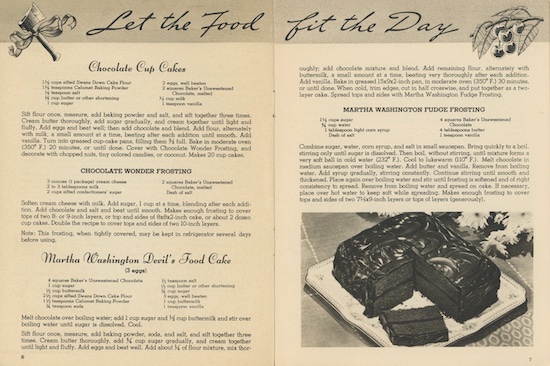
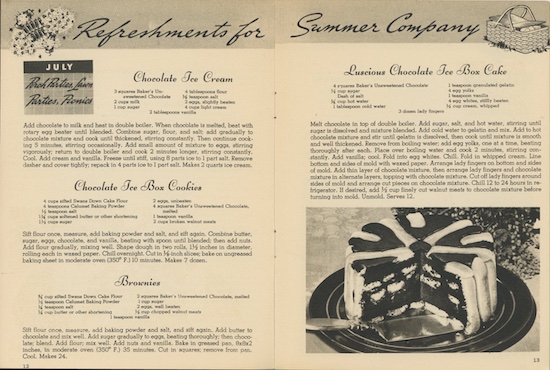
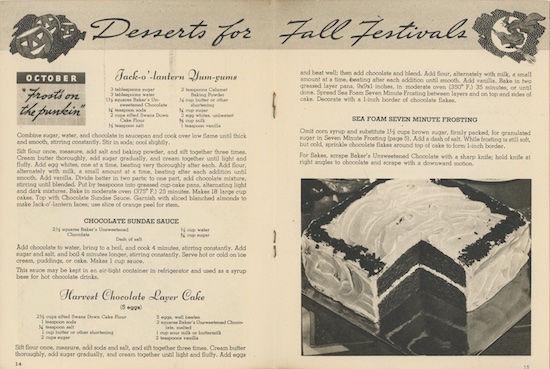

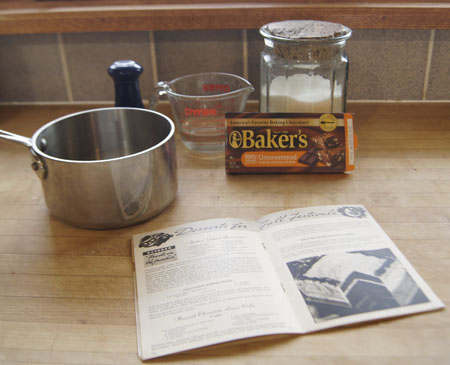 Here’s my helper, doing the stirring chores!
Here’s my helper, doing the stirring chores! Later, after dinner, we enjoyed the sauce over vanilla ice cream and berries.
Later, after dinner, we enjoyed the sauce over vanilla ice cream and berries.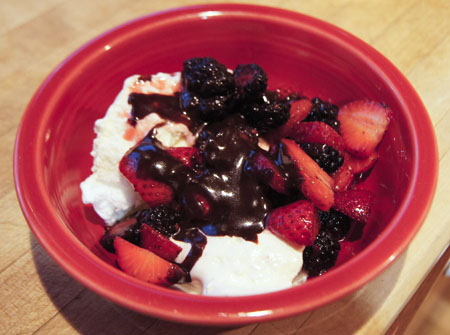 Yum yum yum! It was pretty special to have our own homemade sauce.
Yum yum yum! It was pretty special to have our own homemade sauce.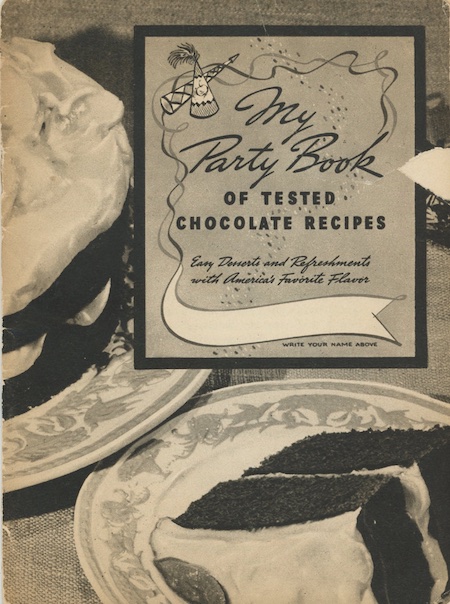
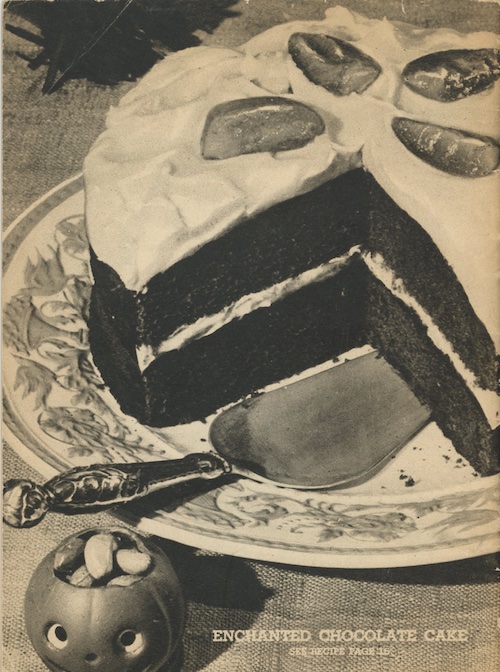
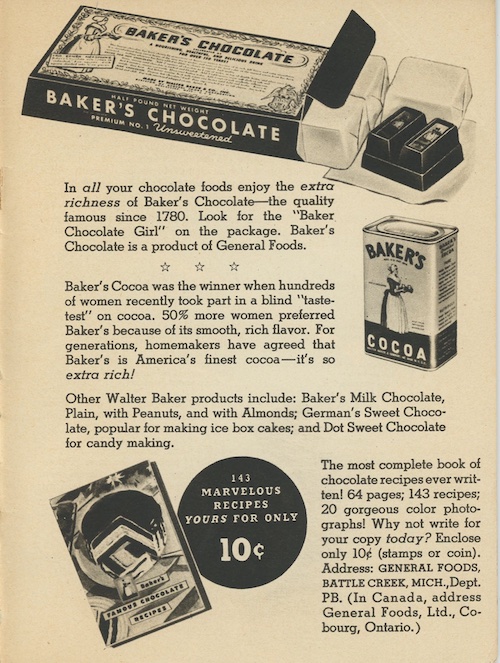

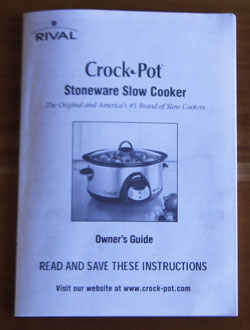 This is my current crock pot. It replaced a nearly-broken one in about 2006. This one has a removable stoneware crock that makes it easy to clean, a high-low setting, and a timer. This is my first crock pot with a timer, and I’d always get one like this from now on.
This is my current crock pot. It replaced a nearly-broken one in about 2006. This one has a removable stoneware crock that makes it easy to clean, a high-low setting, and a timer. This is my first crock pot with a timer, and I’d always get one like this from now on.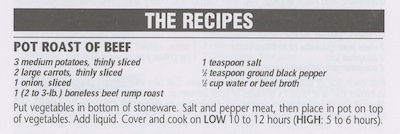
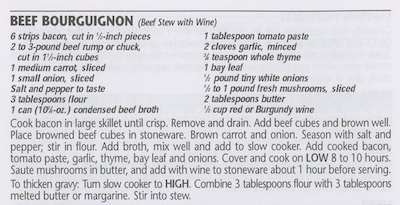 My version is below. I added more stock and more wine, and found that these changes gave just the right amount and thickness of gravy at the end. I used double the amount of tomato paste. I did not add the 3 tablespoons butter plus 3 tablespoons flour at the very end to thicken the broth, but I suggest you do that if you want a really thick gravy.
My version is below. I added more stock and more wine, and found that these changes gave just the right amount and thickness of gravy at the end. I used double the amount of tomato paste. I did not add the 3 tablespoons butter plus 3 tablespoons flour at the very end to thicken the broth, but I suggest you do that if you want a really thick gravy.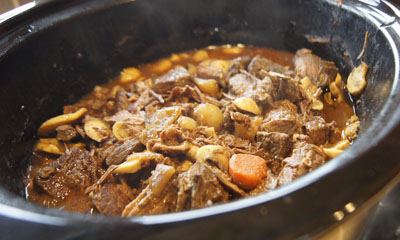 This was totally yummy. I loved the rich, dark broth-gravy. I am glad I didn’t add the flour/butter mixture at the end to thicken the gravy. It was rich and thick enough for me as it was – it was indeed “especially tasty”. I’m also glad I added more wine than called for in the recipe. I liked the sautéd mushrooms added for the last hour – their texture and flavor were not lost by 8 hours of cooking.
This was totally yummy. I loved the rich, dark broth-gravy. I am glad I didn’t add the flour/butter mixture at the end to thicken the gravy. It was rich and thick enough for me as it was – it was indeed “especially tasty”. I’m also glad I added more wine than called for in the recipe. I liked the sautéd mushrooms added for the last hour – their texture and flavor were not lost by 8 hours of cooking.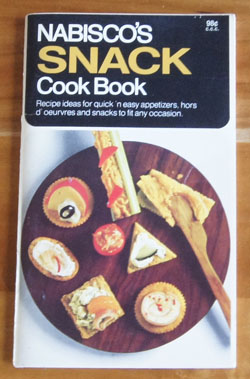 “Dear Homemaker,
“Dear Homemaker, Note the author of the introduction – Mary Ellen Baker, Home Economist. “Baker”? Really?
Note the author of the introduction – Mary Ellen Baker, Home Economist. “Baker”? Really? Here are some more pages from this book.
Here are some more pages from this book.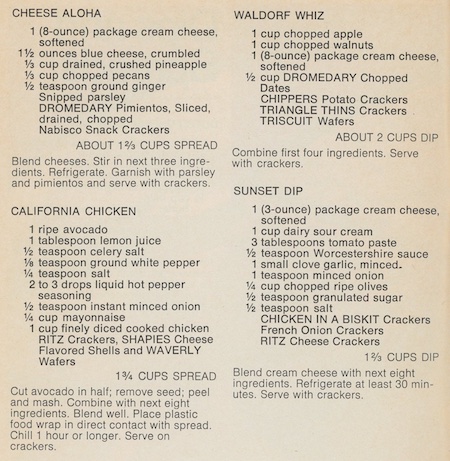
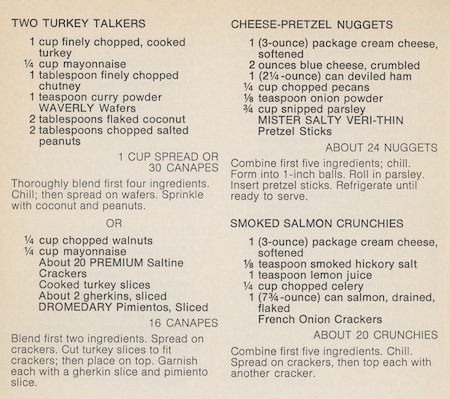
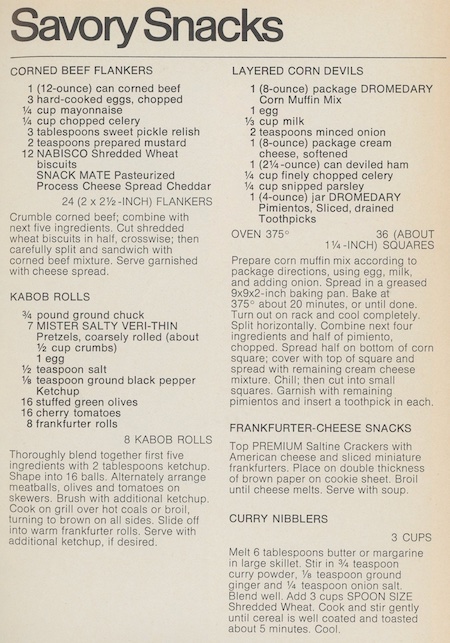 Sweet Snacks include Coconut Orange Dreams (stacks of three vanilla wafers layered with frosting – count out those 54 Nilla Wafers!) and Apricot Coconut Pixies.
Sweet Snacks include Coconut Orange Dreams (stacks of three vanilla wafers layered with frosting – count out those 54 Nilla Wafers!) and Apricot Coconut Pixies.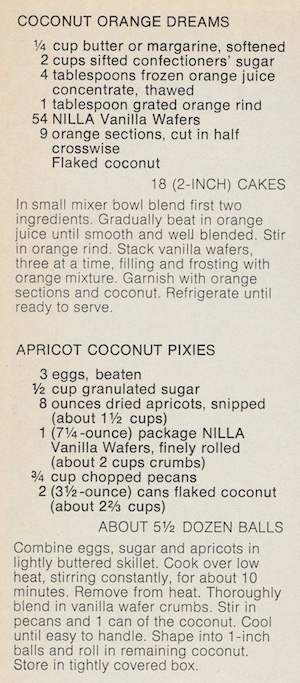
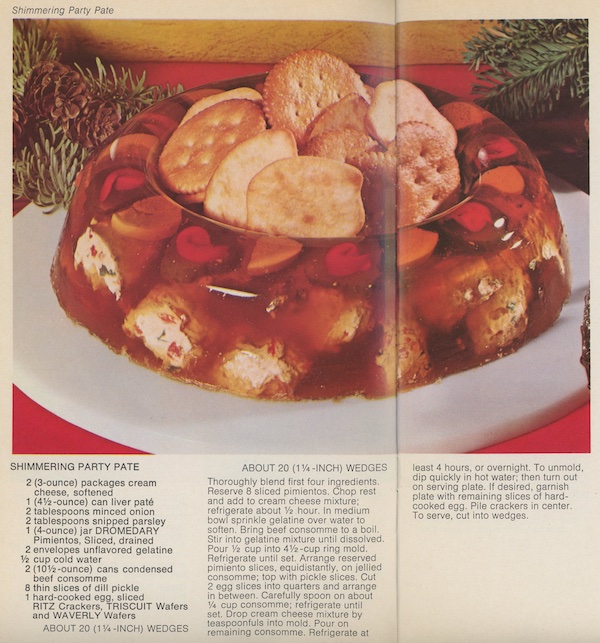 Cheese Neapolitan, pictured below, has 3 layers. The bottom layer is cream cheese and Parmesan cheese colored with tomato paste, the middle layer cream cheese and ricotta cheese, and the top layer cream cheese and Bel Paese cheese covered with parsley.
Cheese Neapolitan, pictured below, has 3 layers. The bottom layer is cream cheese and Parmesan cheese colored with tomato paste, the middle layer cream cheese and ricotta cheese, and the top layer cream cheese and Bel Paese cheese covered with parsley.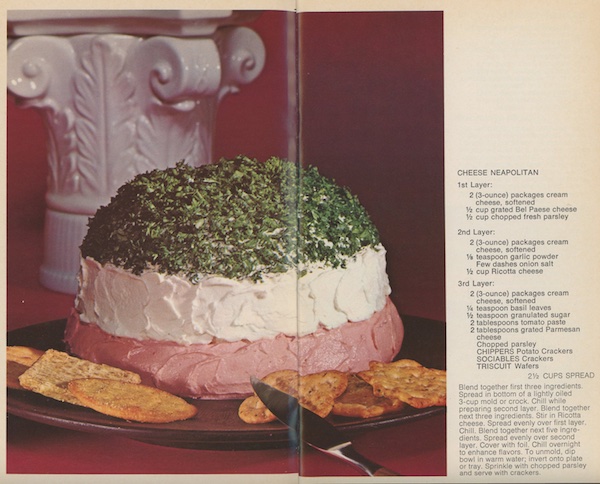 And one more, Curried Chicken Tidbits.
And one more, Curried Chicken Tidbits.
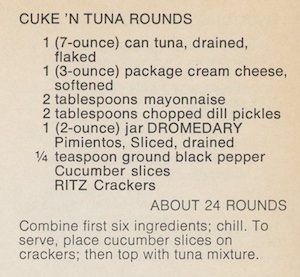

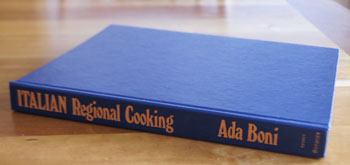 In my “250 Cookbooks” data base, I entered the publication date for this book as “1969?” Huh? Why the question mark. I went to the copyright page of Italian Regional Cooking and found “© MCMLXIX”. Oh, I see, and sure enough, when I read the whole field in my database, it reads “1969? MCMLXIX”. I had translated the Roman numeral to an Arabic numeral as “1969”, but didn’t check to see if I was correct. Turns out I was: search engines today quickly pulled up the conversion of MCMLXIX to 1969. Kids today no longer need to learn those rules in school, I guess.
In my “250 Cookbooks” data base, I entered the publication date for this book as “1969?” Huh? Why the question mark. I went to the copyright page of Italian Regional Cooking and found “© MCMLXIX”. Oh, I see, and sure enough, when I read the whole field in my database, it reads “1969? MCMLXIX”. I had translated the Roman numeral to an Arabic numeral as “1969”, but didn’t check to see if I was correct. Turns out I was: search engines today quickly pulled up the conversion of MCMLXIX to 1969. Kids today no longer need to learn those rules in school, I guess.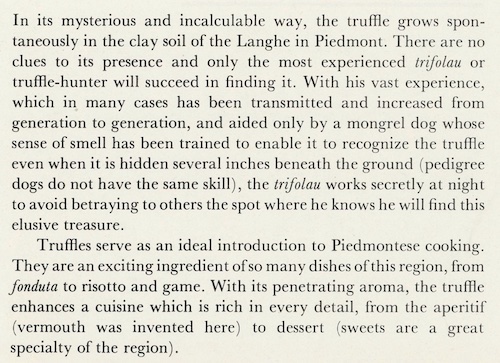
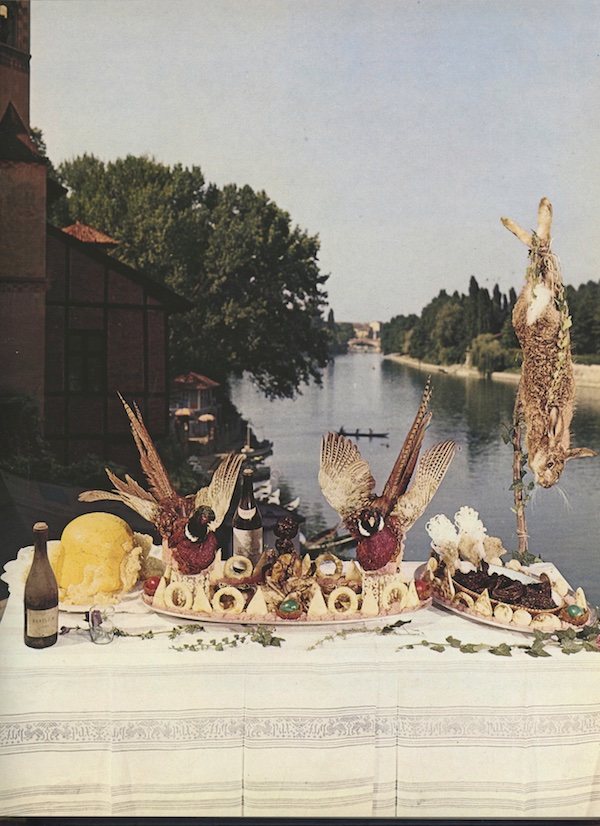
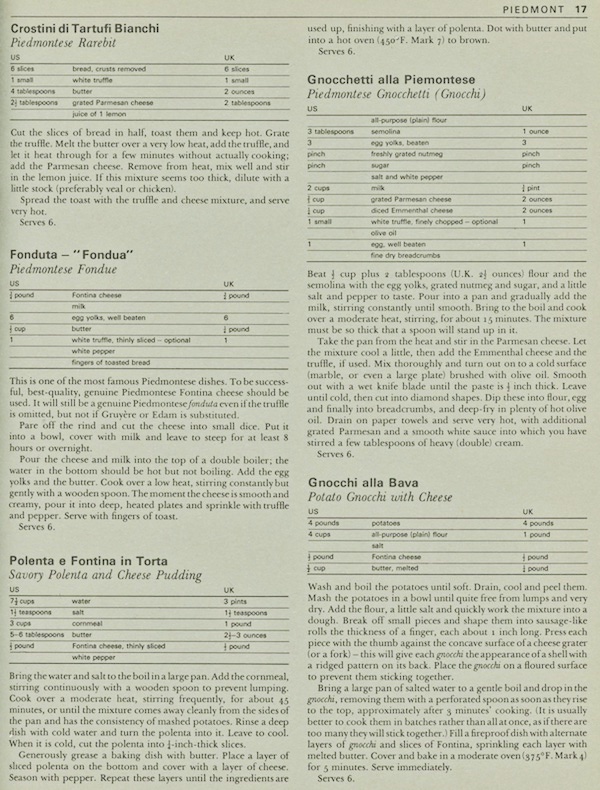 Here is another example of recipes in the Piedmont chapter. These ingredients aren’t as “Patty-friendly” as they are sweetbreads, oxtail, and frogs legs.
Here is another example of recipes in the Piedmont chapter. These ingredients aren’t as “Patty-friendly” as they are sweetbreads, oxtail, and frogs legs.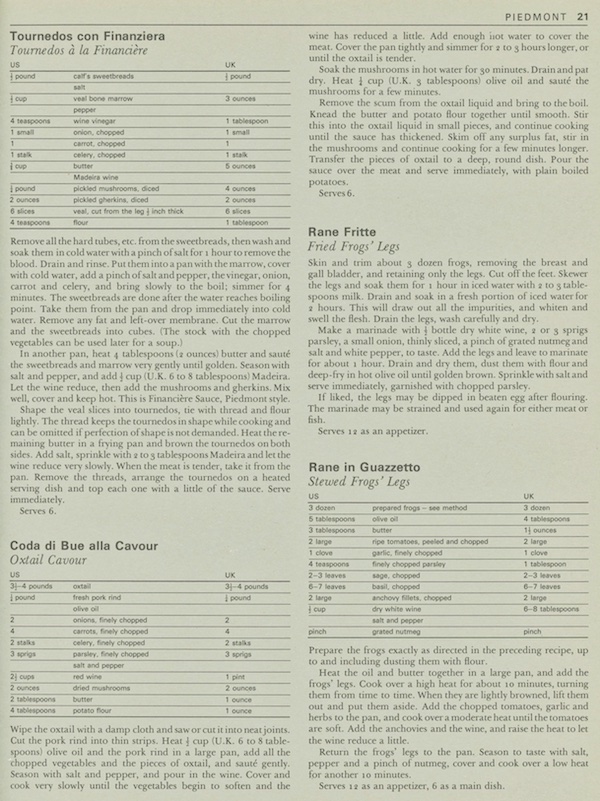
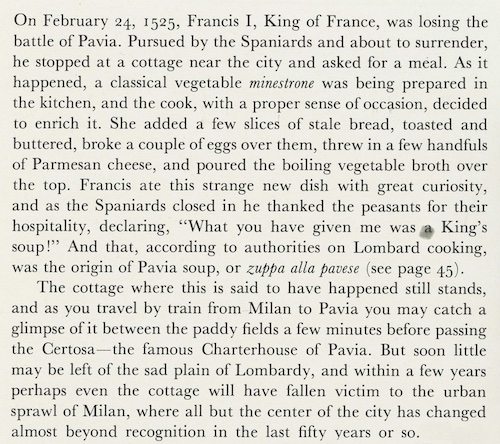
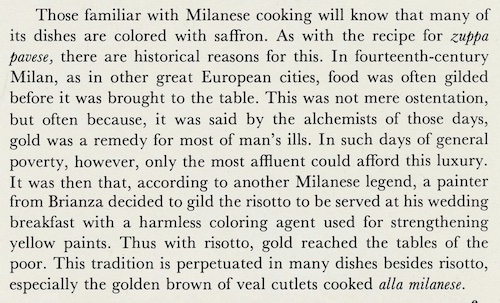

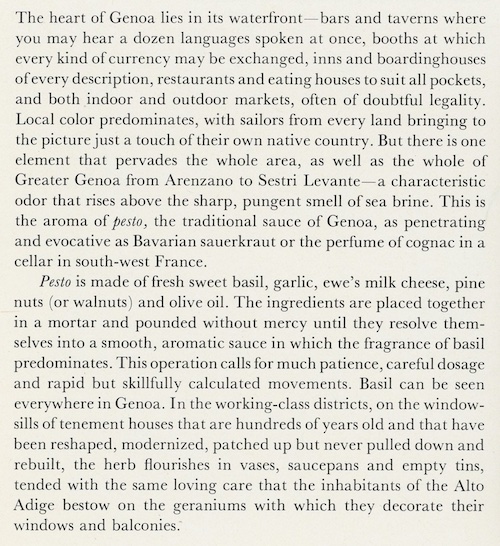 Here is a recipe for pesto:
Here is a recipe for pesto: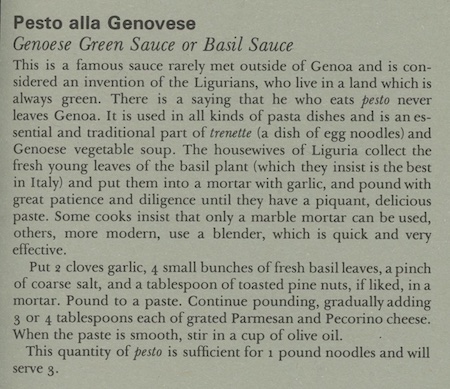
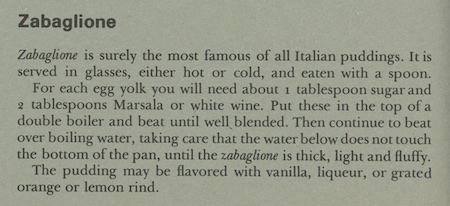 And so Ida Boni’s Italian Regional Cooking continues. I turn the pages and enjoy new stories, and more wonderful photos of the regions of Italy. It is a very good read.
And so Ida Boni’s Italian Regional Cooking continues. I turn the pages and enjoy new stories, and more wonderful photos of the regions of Italy. It is a very good read.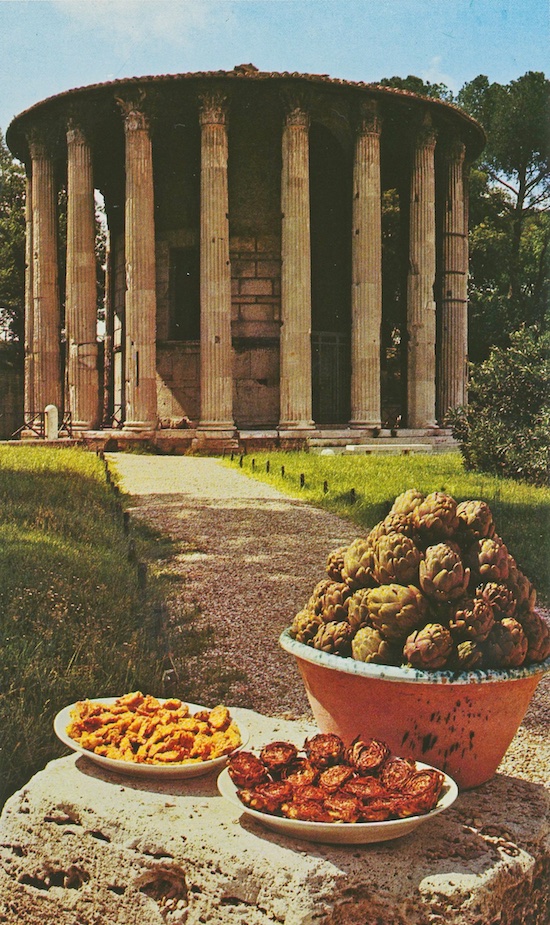
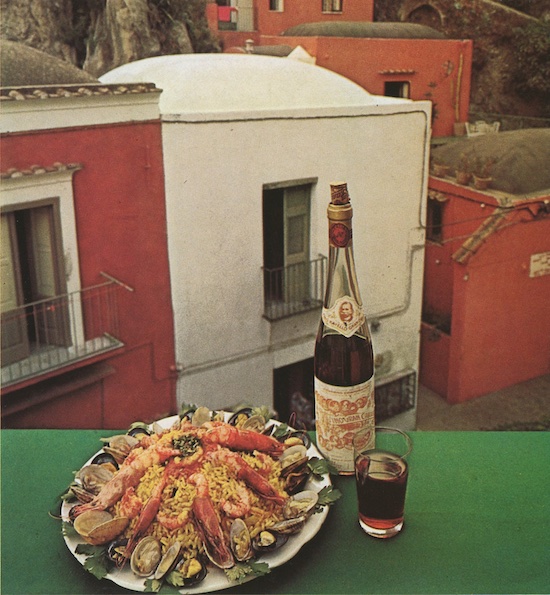
 This is a simple soup, just meat balls and noodles in broth. The only herb is parsley. As I was preparing it, I had to keep my hand from grabbing my usual Italian spices, like oregano, basil, and thyme. I also had to stop from adding vegetables to this soup, like carrots, celery, and onions. The only change I made was to halve the recipe to serve only two people, but keep the amount of ground beef the same (1/2 pound). Oh – at the last minute I added about 3 tablespoons tomato sauce. I’ll leave that as optional.
This is a simple soup, just meat balls and noodles in broth. The only herb is parsley. As I was preparing it, I had to keep my hand from grabbing my usual Italian spices, like oregano, basil, and thyme. I also had to stop from adding vegetables to this soup, like carrots, celery, and onions. The only change I made was to halve the recipe to serve only two people, but keep the amount of ground beef the same (1/2 pound). Oh – at the last minute I added about 3 tablespoons tomato sauce. I’ll leave that as optional. This was a very thick and very filling soup. It was good, but actually too much for the two of us. I might make it the same way again, or I’d use half the amount of meatballs and serve it as a first course. The flavor was good and I always like meat balls, so I wasn’t complaining!
This was a very thick and very filling soup. It was good, but actually too much for the two of us. I might make it the same way again, or I’d use half the amount of meatballs and serve it as a first course. The flavor was good and I always like meat balls, so I wasn’t complaining!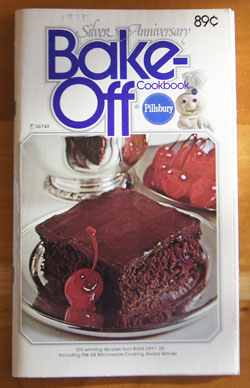 The Silver Anniversary Bake-Off Cookbook is one of the 22 cookbooks or cookbooklets on my shelves. The publication dates vary from 1959-2000, and most were my Mother’s. Some have good recipes, and some not-so-good recipes, but they reflect Americana of late twentieth century USA.
The Silver Anniversary Bake-Off Cookbook is one of the 22 cookbooks or cookbooklets on my shelves. The publication dates vary from 1959-2000, and most were my Mother’s. Some have good recipes, and some not-so-good recipes, but they reflect Americana of late twentieth century USA.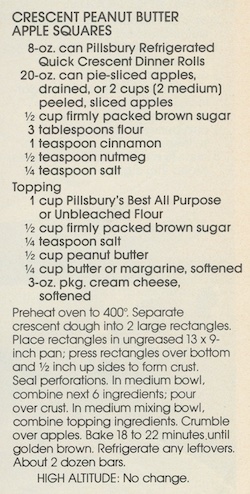
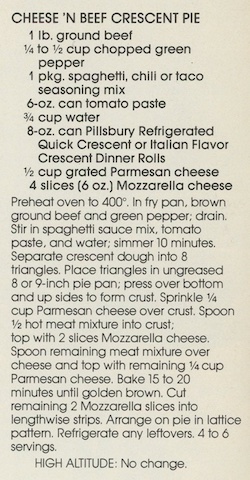
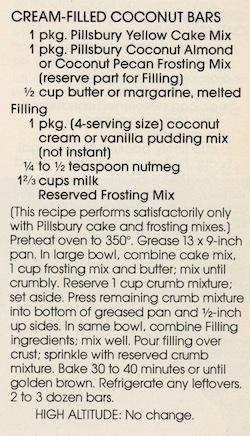
 The fresh apples, cheese, nuts, and coconut in this recipe are all on our approved list of foods. Note that there is no butter or shortening in the recipe. The sugar? A no-no for us. I’ll wait to make these until we have company.
The fresh apples, cheese, nuts, and coconut in this recipe are all on our approved list of foods. Note that there is no butter or shortening in the recipe. The sugar? A no-no for us. I’ll wait to make these until we have company. I am on the final 15 cookbooks in my “250 Cookbooks” database! It’s time to do the last Encyclopedia of Cookery in my collection. I open the volume and settle in to another discovery of unusual food items and historical trivia. As well as some useful recipes, of course. Encyclopedia of Cookery, Vol. 12, Top-Z-Index covers “topping” to “zwieback”.
I am on the final 15 cookbooks in my “250 Cookbooks” database! It’s time to do the last Encyclopedia of Cookery in my collection. I open the volume and settle in to another discovery of unusual food items and historical trivia. As well as some useful recipes, of course. Encyclopedia of Cookery, Vol. 12, Top-Z-Index covers “topping” to “zwieback”. And now from truffles to the lowly can of tuna. I am not surprised to find a “Tuna Cook Book” in this 1960s cookbook. “Tonno con Piselli” is tuna with peas, yes, just canned tuna and peas. The “Tuna-Macaroni Bake” is like the tuna casseroles I remember; this one is topped with crushed potato chips. (I love potato chips on tuna sandwiches.)
And now from truffles to the lowly can of tuna. I am not surprised to find a “Tuna Cook Book” in this 1960s cookbook. “Tonno con Piselli” is tuna with peas, yes, just canned tuna and peas. The “Tuna-Macaroni Bake” is like the tuna casseroles I remember; this one is topped with crushed potato chips. (I love potato chips on tuna sandwiches.) The Turkey Cook Book might be useful because it has a lot of recipes for using leftover turkey. Next come turmeric, turnip, and turnovers. Oh, turtle soup! And if I want to know how to dress a live turtle:
The Turkey Cook Book might be useful because it has a lot of recipes for using leftover turkey. Next come turmeric, turnip, and turnovers. Oh, turtle soup! And if I want to know how to dress a live turtle:



 “There is a mystifying phenomenon in the order of courses in the West.” Namely, salads are served first. Yay for California for starting this trend! It’s the rule at my house, and I learned it from my college roommates.
“There is a mystifying phenomenon in the order of courses in the West.” Namely, salads are served first. Yay for California for starting this trend! It’s the rule at my house, and I learned it from my college roommates. In the 1960s, one could find frozen whale steaks in local specialty food stores, and I learn that 3 1/2 ounces raw whale has 156 calories. Apparently you could still find whale meat at online specialty shops in the 1960s (and maybe online today). Lots of fish begins with “wh” – white fish, whiting, and whitebait are examples. And of course two of my favorite things begin “wh” – wheat and whiskey. Wild rice is a native American grass that is not directly related to Asian rice.
In the 1960s, one could find frozen whale steaks in local specialty food stores, and I learn that 3 1/2 ounces raw whale has 156 calories. Apparently you could still find whale meat at online specialty shops in the 1960s (and maybe online today). Lots of fish begins with “wh” – white fish, whiting, and whitebait are examples. And of course two of my favorite things begin “wh” – wheat and whiskey. Wild rice is a native American grass that is not directly related to Asian rice. I like this salad for several reasons. I love toasted walnuts in salads. I like Parmesan cheese too, especially when it is freshly grated from a chunk of Parmigiano Reggiano. I like the fact that you make a special salad dressing, just enough for this salad. And, I like using “coarsely torn and loosely measured salad greens”. That’s my typical way of making salads! I am sure I used a lot more salad greens than one cup per person, though. I like my salads.
I like this salad for several reasons. I love toasted walnuts in salads. I like Parmesan cheese too, especially when it is freshly grated from a chunk of Parmigiano Reggiano. I like the fact that you make a special salad dressing, just enough for this salad. And, I like using “coarsely torn and loosely measured salad greens”. That’s my typical way of making salads! I am sure I used a lot more salad greens than one cup per person, though. I like my salads. This is a great-tasting salad that I will make again. Refreshing, after my usual salads overladen with fresh cut vegetables. Entirely suitable for a special dinner! Note that I used walnut halves. Coarsely broken walnuts might give a slightly different taste to this salad.
This is a great-tasting salad that I will make again. Refreshing, after my usual salads overladen with fresh cut vegetables. Entirely suitable for a special dinner! Note that I used walnut halves. Coarsely broken walnuts might give a slightly different taste to this salad.
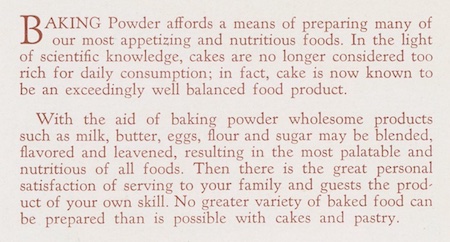


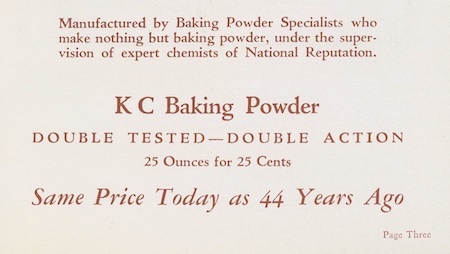 Jaques Manufacturing Company was given the Distinguished Service Award.
Jaques Manufacturing Company was given the Distinguished Service Award.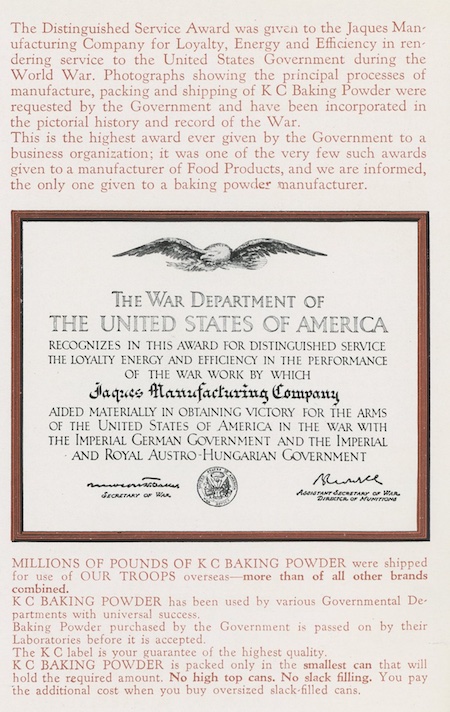
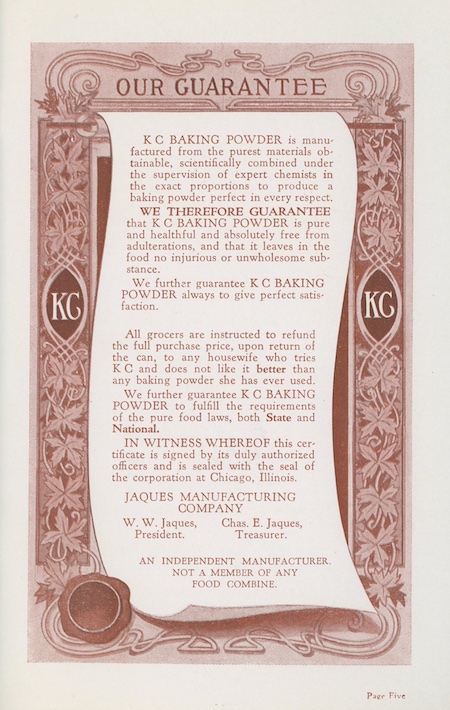

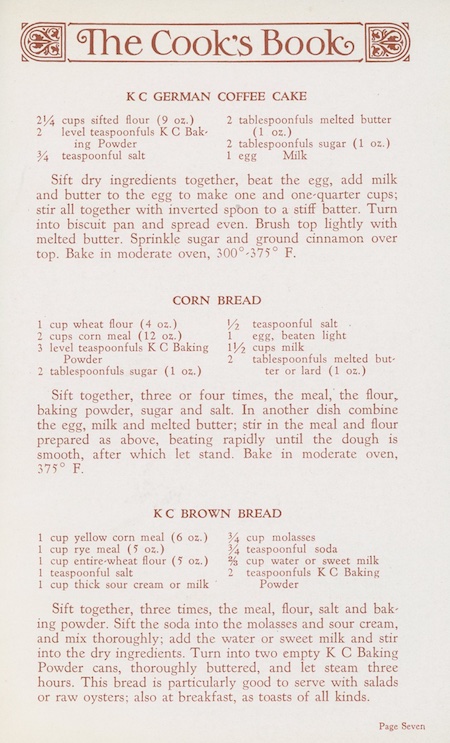
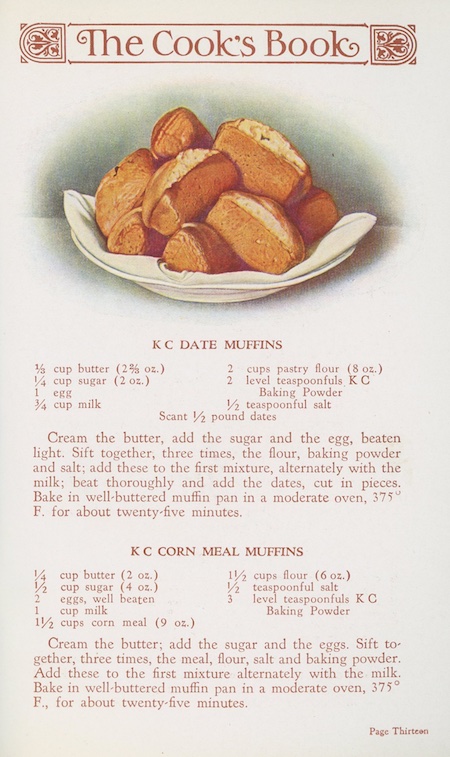
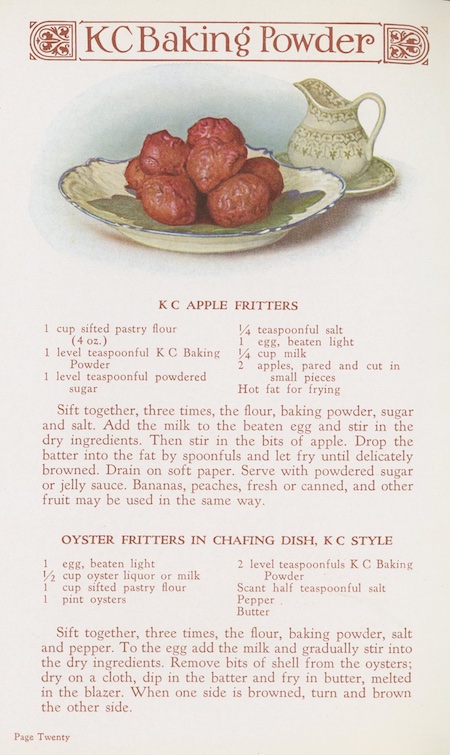
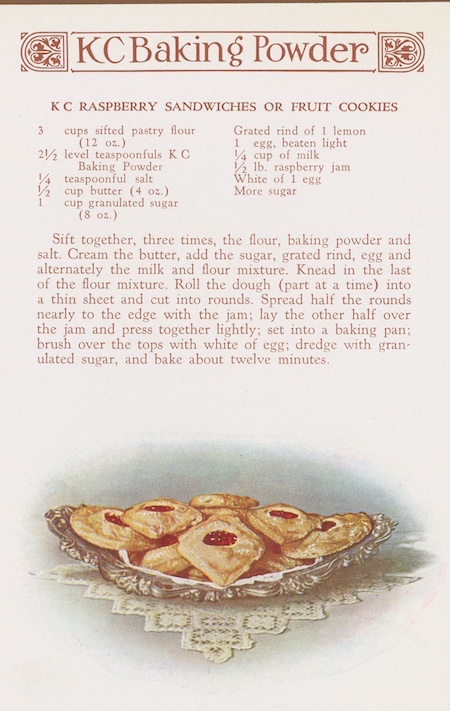
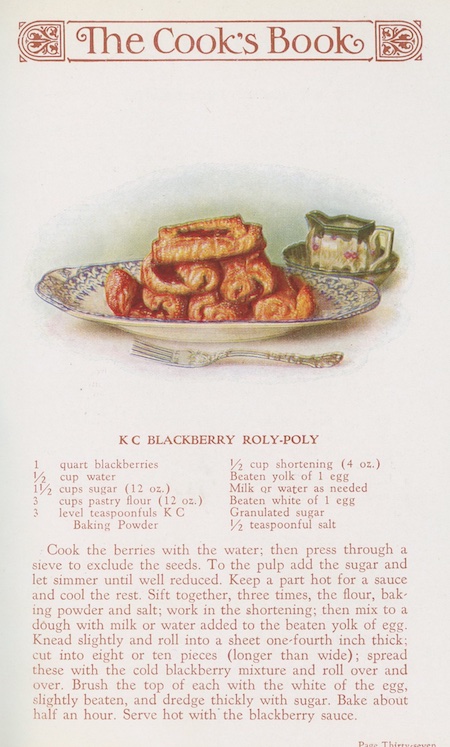

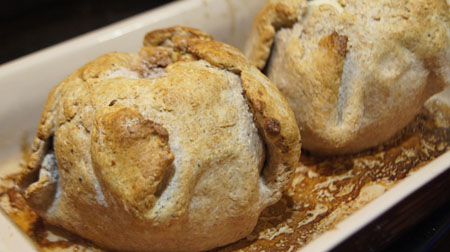
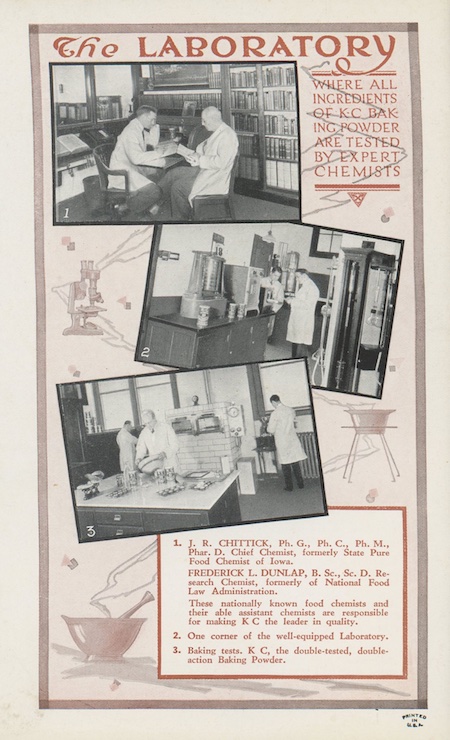
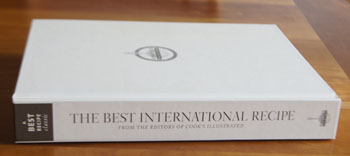
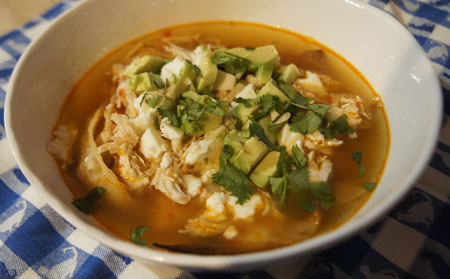
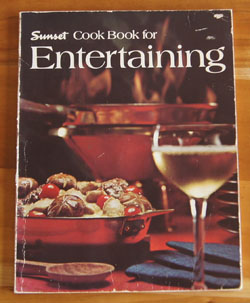 Entertaining, not my forté! I’m a bit too much of an introvert so I’ve never practiced it a lot. Sort of shy. And don’t get me wrong, I love cooking for people, but when it comes to presentation, I am lacking in ability and (desire). When company comes over (usually family), I want something delicious to serve and I don’t want diners getting full on appetizers. Save room for dessert!
Entertaining, not my forté! I’m a bit too much of an introvert so I’ve never practiced it a lot. Sort of shy. And don’t get me wrong, I love cooking for people, but when it comes to presentation, I am lacking in ability and (desire). When company comes over (usually family), I want something delicious to serve and I don’t want diners getting full on appetizers. Save room for dessert!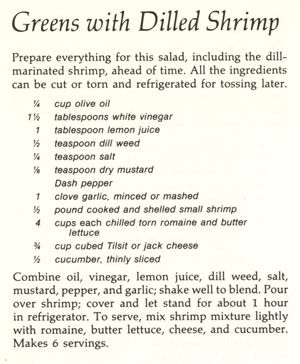 Distinctive Entrees begins: “The entree is the most important part of a meal, and the deciding factor in all the other things you serve before, with, or after.” Let’s see what they have. Most of the recipes sound good, like Beef Burgundy, Veal Veronique, and Giant Beef-Lobster Kebabs. But what I like about this chapter’s recipes is that almost each one requires very little last minute prep from the cook: “The foremost consideration in the selection of these entrees has been whether they are practical for entertaining. Nearly all of these dishes may be made partially or entirely ahead; many may be frozen.” A few of the recipes look very involved but I might find them fun: Danish Chicken and Meatblls au Gratin, for instance, calls for veal meatballs, chicken breasts, and sweetbreads, all cooked and assembled in a rich sauce ahead of time and simply heated briefly just before serving. “Pheasant-in-a-Bag” is an example of one of the more unusual dishes in this chapter. I note a recipe for Turkey Tetrazzini, one I’ve come across several times in cookbooks of this era, and one that I have explored before (
Distinctive Entrees begins: “The entree is the most important part of a meal, and the deciding factor in all the other things you serve before, with, or after.” Let’s see what they have. Most of the recipes sound good, like Beef Burgundy, Veal Veronique, and Giant Beef-Lobster Kebabs. But what I like about this chapter’s recipes is that almost each one requires very little last minute prep from the cook: “The foremost consideration in the selection of these entrees has been whether they are practical for entertaining. Nearly all of these dishes may be made partially or entirely ahead; many may be frozen.” A few of the recipes look very involved but I might find them fun: Danish Chicken and Meatblls au Gratin, for instance, calls for veal meatballs, chicken breasts, and sweetbreads, all cooked and assembled in a rich sauce ahead of time and simply heated briefly just before serving. “Pheasant-in-a-Bag” is an example of one of the more unusual dishes in this chapter. I note a recipe for Turkey Tetrazzini, one I’ve come across several times in cookbooks of this era, and one that I have explored before (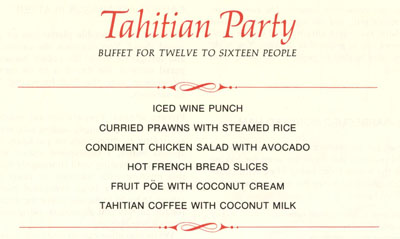

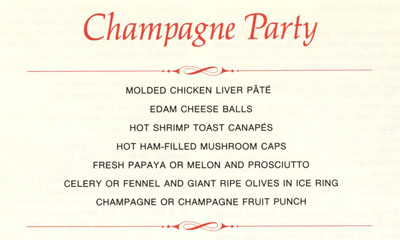
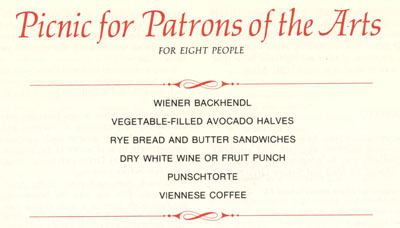
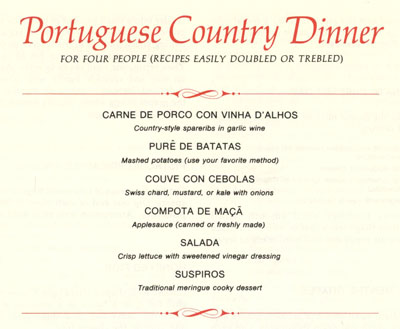
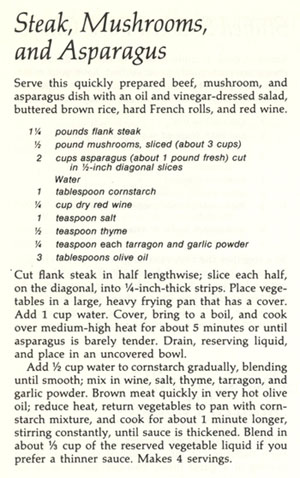 I’ve adjusted the herbs and thickening agent (cornstarch) up a bit to our own tastes, and made twice the amount of sauce.
I’ve adjusted the herbs and thickening agent (cornstarch) up a bit to our own tastes, and made twice the amount of sauce.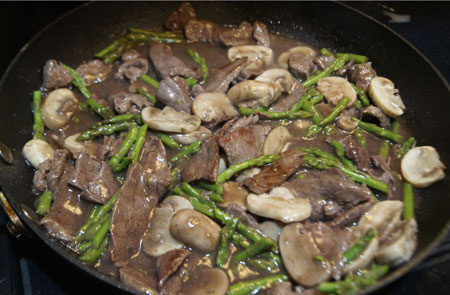 I liked this a lot, but all I got was a “pretty good” from my hubby. He is used to this type of meal with a lot of soy sauce; I, on the other hand, appreciated the subtle red wine sauce. I am not an asparagus fan, but the asparagus I found at the store was very small and young, and cut into the small pieces, I found it to be quite good.
I liked this a lot, but all I got was a “pretty good” from my hubby. He is used to this type of meal with a lot of soy sauce; I, on the other hand, appreciated the subtle red wine sauce. I am not an asparagus fan, but the asparagus I found at the store was very small and young, and cut into the small pieces, I found it to be quite good.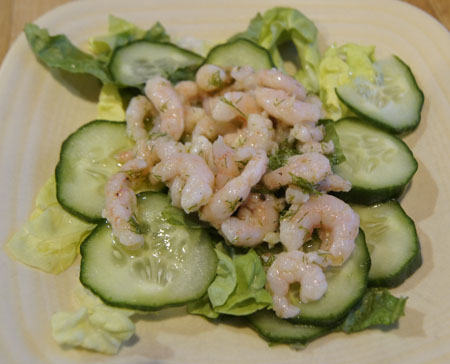 I have decided to keep this cookbook. Online, I find that it is still for sale (used) for several dollars a copy. And I found one favorable review – so I know I am not alone in appreciating this book. I have always liked the type of Southwestern cuisine that Sunset magazine promotes. Another “found” cookbook, right on my shelves!
I have decided to keep this cookbook. Online, I find that it is still for sale (used) for several dollars a copy. And I found one favorable review – so I know I am not alone in appreciating this book. I have always liked the type of Southwestern cuisine that Sunset magazine promotes. Another “found” cookbook, right on my shelves!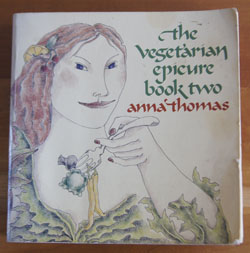 The Vegetarian Epicure Book Two is pleasantly illustrated and is printed on solid, rough paper – such a good tactile touch. Anna Thomas is a friendly author, and the recipes straightforward. I bought this cookbook for myself, and I’m sure that I leafed through it at the store and was intrigued by the look of the book and the variety of recipes.
The Vegetarian Epicure Book Two is pleasantly illustrated and is printed on solid, rough paper – such a good tactile touch. Anna Thomas is a friendly author, and the recipes straightforward. I bought this cookbook for myself, and I’m sure that I leafed through it at the store and was intrigued by the look of the book and the variety of recipes.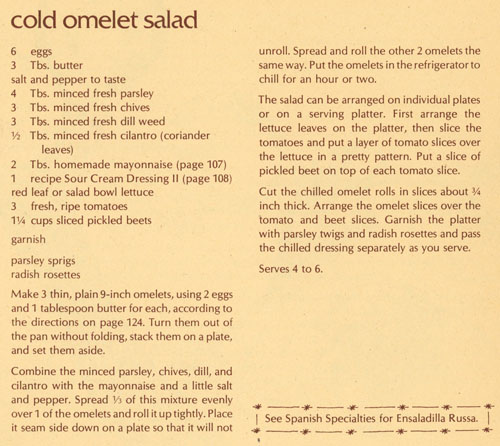
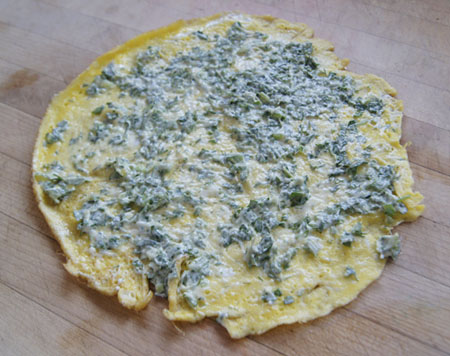 Carefully roll the omelet. Chill a couple hours, then cut into 3/4-inch pieces to serve as a snack.
Carefully roll the omelet. Chill a couple hours, then cut into 3/4-inch pieces to serve as a snack. We enjoyed these as a late-afternoon snack – they are delicious! We both liked them.
We enjoyed these as a late-afternoon snack – they are delicious! We both liked them.